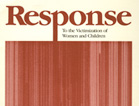Confronting Violence, Improving Women’s Lives provides resources for educators and students to further classroom studies of domestic violence, or as independent studies. These resources are designed to be starting points for exploring historical perspectives and existing tools and services for ending domestic violence in the United States. Educators are welcome to adapt these resources in whole or in part as appropriate for their students’ interests and learning goals.
Lesson Plans
Domestic Violence Unit
- Grade levels: intermediate English language learners
- subject: health education
This instructional unit is one of the online resources from the Minnesota Literacy Council’s Curriculum and Lesson Plans web page. It provides classroom activities and materials for a one-week curriculum that focuses on students’ becoming familiar with what is domestic and dating violence, who it affects, and what resources are available for help.
Judges in the Classroom Lesson Plan: Domestic Violence
- Grade levels: 9–12
- subject: history & social studies
This lesson engages students in understanding and evaluating domestic/dating violence acts in conjunction with the laws against such crimes in the state of Washington. It offers simulation scenarios and highlights a couple of state and federal laws for class discussions. This is one of the educational resources on the Washington State Courts website.
Love Is Not Abuse
- Grade levels: 9–12
- subject: literature
This is a literature-based high-school curriculum intended for English teachers to help students understand, identify, and take actions against dating abuse. “Love Is Not Abuse” uses literature and encourages critical thinking in discussions about teen dating abuse and healthy relationships. This is one of the resources provided by Breaking the Cycle’s Youth Leadership and Education web page.
Teen Health: Science Ambassador Lesson Plans
- Grade levels: 7‐12
- subject: science & technology
“Crunching the Numbers on Dating Violence” and “RESPECT—The Data: A Closer Look” are middle- and high-school lesson plans, respectively, from the 2007 Science Ambassador Workshop hosted by the Centers for Disease Control and Prevention. Students use scientific process skills to understand and analyze data about teen dating violence.
Higher Education
Domestic Violence: A History of Reform and Activism in the United States is a module developed for undergraduate and graduate level courses to accompany the National Library of Medicine exhibition, Confronting Violence, Improving Women’s Lives. Amy C. Sullivan, PhD, authored this module that uses women’s history and the history of domestic violence to promote understanding of reform efforts over the past three centuries. The module analyzes current knowledge and best practices for victims of relationship violence.
Online Activities
Lipstick tubes, nail files, and a business card are ordinary items that a person may carry. But are they? Examine these three small items that are designed to help survivors and victims of domestic violence carry safety information discretely until needed.
People from a wide variety of reform movements have undertaken efforts to address the many different factors that affect women’s wellbeing. Create a collage of women and men who have worked to improve women’s lives and health.
Other Resources
Continue to learn about the history, causes and effects, and prevention strategies related to domestic violence. Examine its history in the United States, starting with the Curator’s Bibliography. Explore how one may seek help, as well as get involved in preventing domestic and other kinds of violence by accessing several online examples of programs, services, and suggested readings that are listed under Online Resources.
Continue to Other Resources





